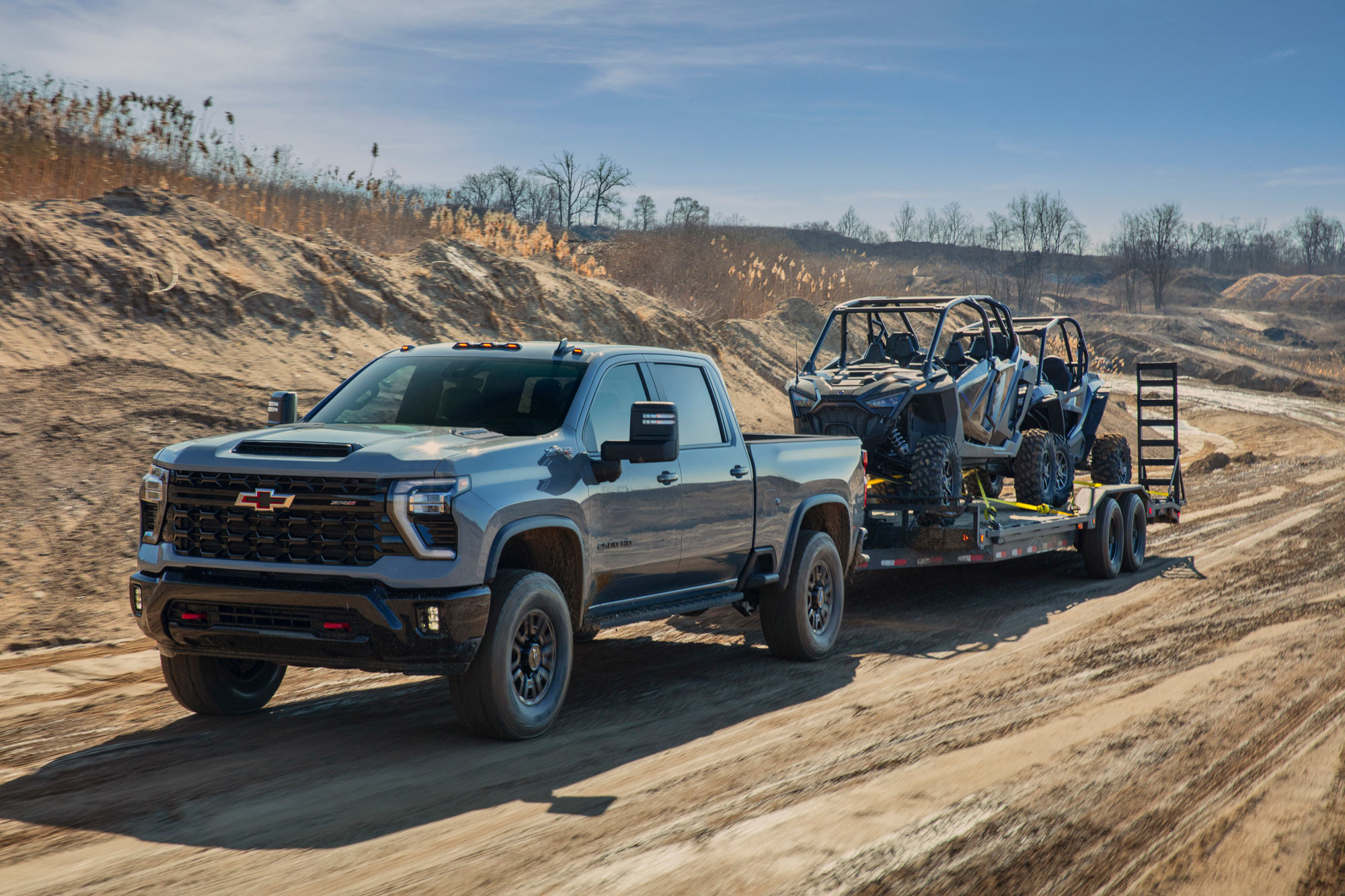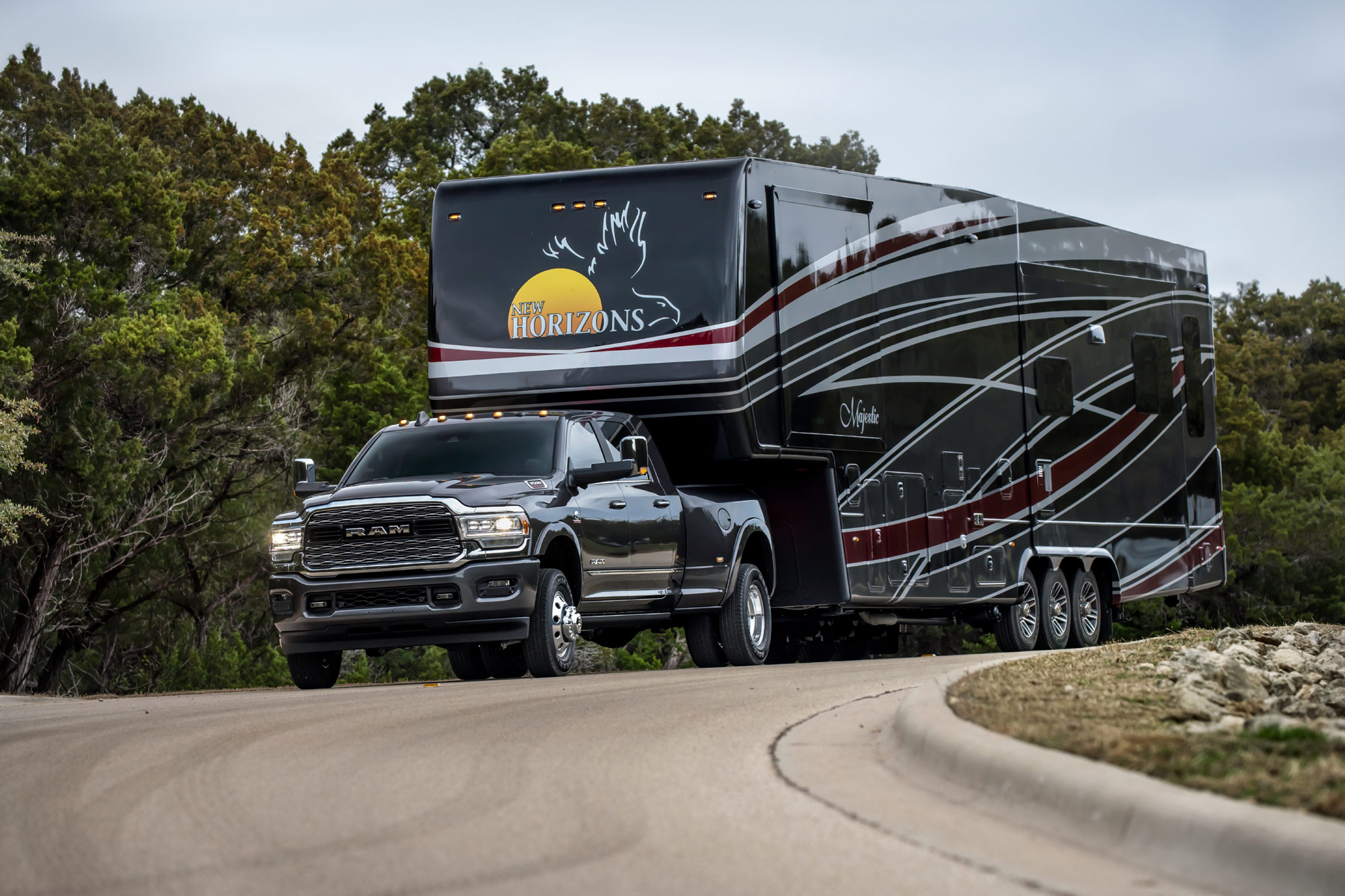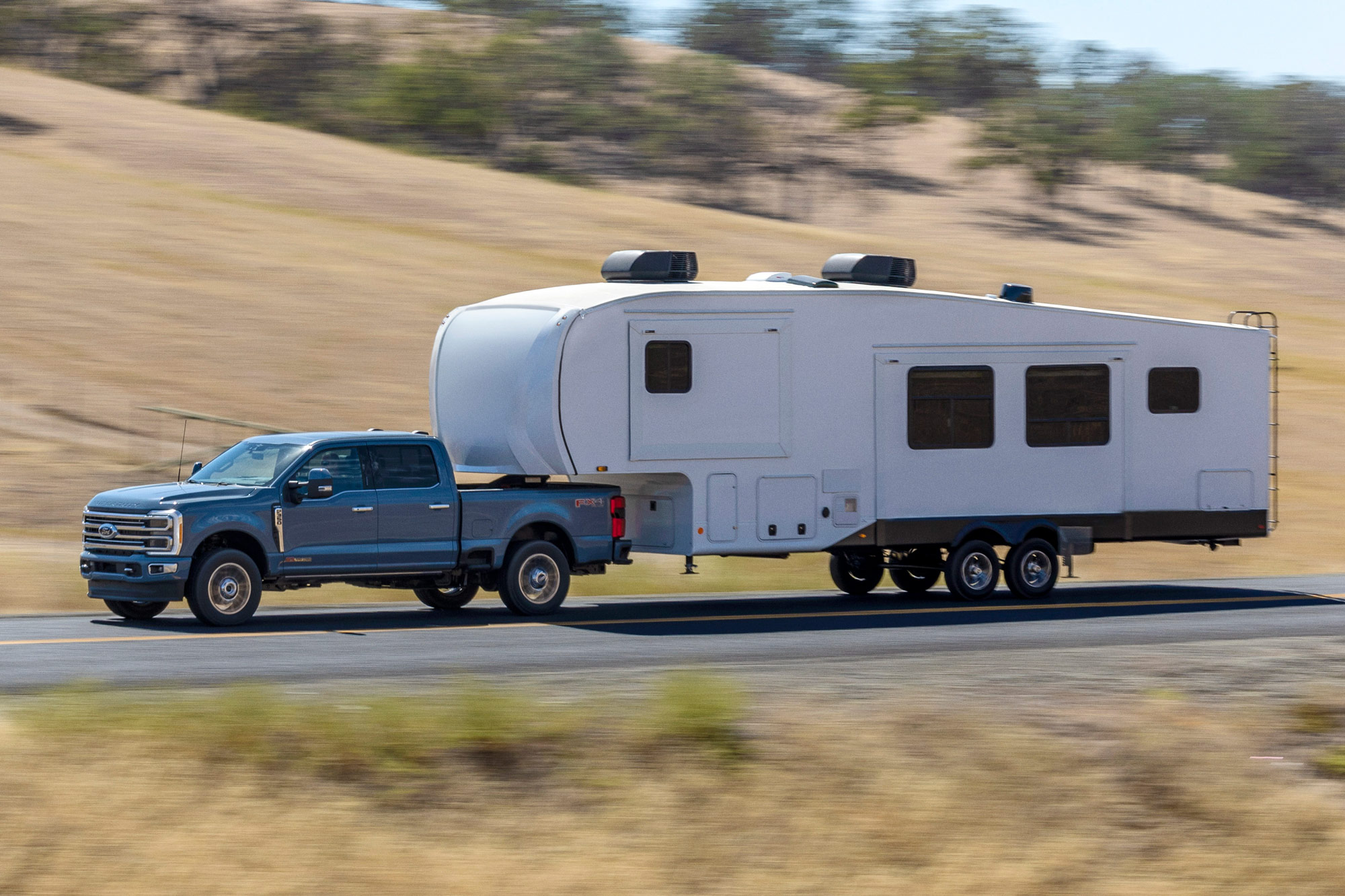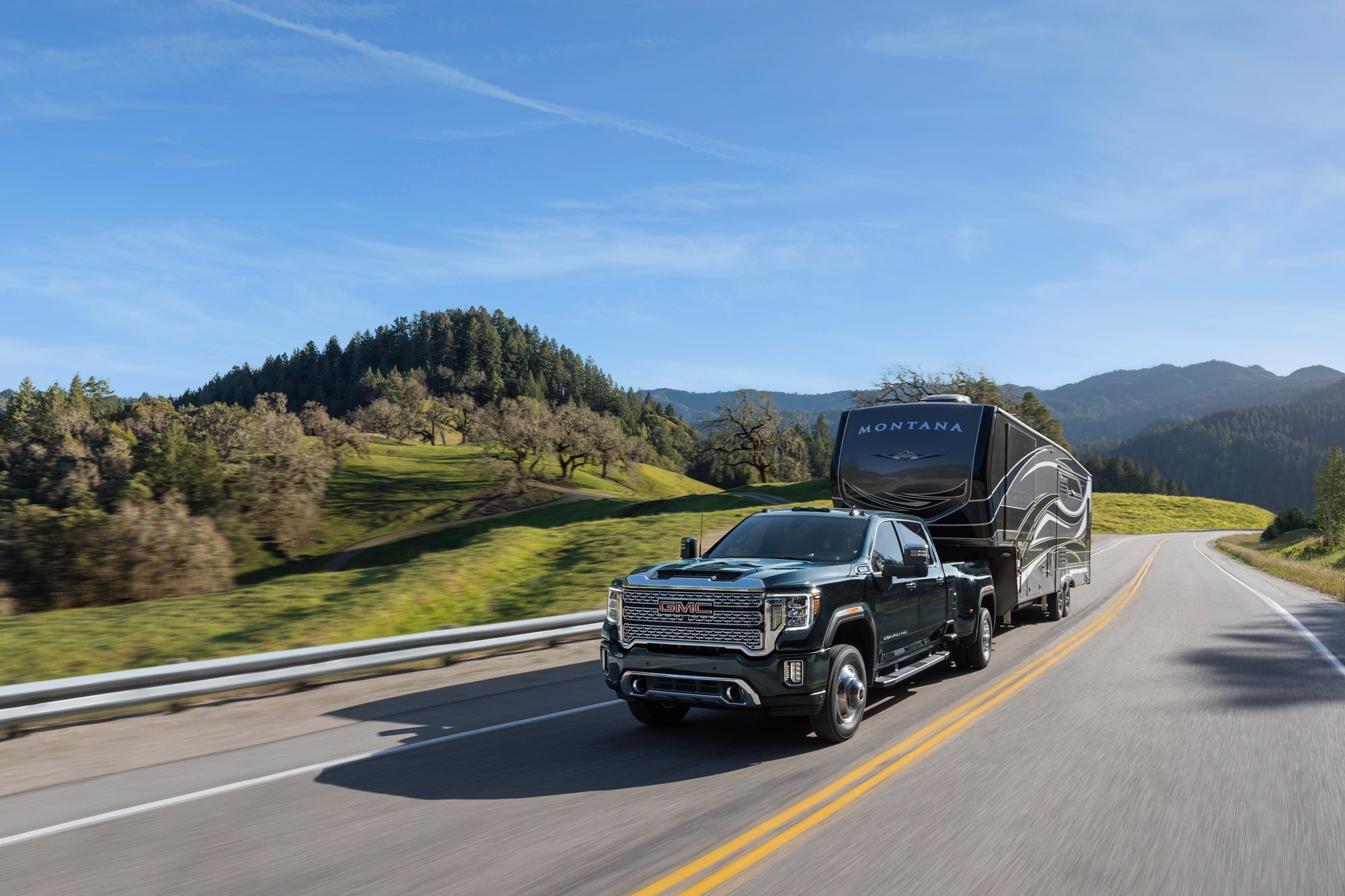What Makes a Pickup Truck Heavy Duty?
These big trucks can tow and haul more than their light-duty counterparts.
 Chevrolet
Chevrolet
Pickup trucks are perhaps the most configurable consumer vehicles and therefore it can be difficult for potential buyers to figure out what options and combinations to choose. Trucks can come in different cab layouts, bed sizes, and wheelbases, with a variety of trims, engines, transmissions, and transfer cases available.
They're also generally sorted into two categories — light-duty and heavy-duty — based on their capability. It's a lot to take in. There are several reasons certain models deserve the heavy-duty moniker.
 Ram
Ram
Full-Size Trucks Usually Fit Into One of Two Groups
The domestic brands — Chevrolet, Ford, GMC, Ram — are the only ones that offer both light- and heavy-duty full-size trucks. The Chevy Silverado 1500, Ford F-150, GMC Sierra 1500, and Ram 1500 fall into the light-duty category, while their counterparts with numerically larger names — think Ford F-250, Ram 2500, or Sierra 3500 — are heavy-duty trucks.
To make things just a little more confusing, these pickups can also be categorized as half-ton (1500s and F-150), three-quarter-ton (2500s and F-250), or one-ton (3500s or F-350) pickups. The "ton" descriptors are a holdover from the early days of pickups when they approximated the truck's payload, but hauling capacity has improved quite a bit since then.
Today, even some so-called half-ton trucks can handle more than 2,000 pounds in their beds. For that reason, labeling pickups as "light duty" or "heavy duty" provides a more clear distinction.
And as with many rules, there's an exception. Nissan offers an XD version of its Titan full-size pickup that's supposed to split the difference between the standard Titan and a heavy-duty truck — something Nissan does not make. The Titan XD can in fact out-tow the regular model (a max of 11,050 pounds versus 9,290) and carry more weight in its bed (2,260 pounds to 1,710), yet the F-150 and Ram 1500 can top it in both metrics.
Because of this, the Titan XD could be considered in the light-duty category.
 Ford
Ford
Heavy Duty Trucks Are Built to Tow and Haul More
The main difference between light- and heavy-duty pickups lies in their capabilities. While light-duty payload and towing numbers continue to climb into territory that was once exclusive to the heavy-duty pickups of yore, heavy-duty truck numbers keep climbing as well. In general, a heavy-duty version of a truck will tow and haul more than its light-duty counterpart.
Heavy-duty trucks meet their higher duty cycles through a variety of mechanical changes that make them stronger and increase their endurance compared with their light-duty cousins. Additional cooling — for the engine, oil system, and transmission — allows heavy-duty trucks to tow and haul more weight for longer periods.
A heavy-duty truck's frame is generally stronger and more torsionally rigid to help it deal with bigger loads and keep its composure both on and off-road. Beefier suspension components also contribute to high payload and trailering maximums. In order to accommodate those large loads, heavy-duty trucks have much stiffer suspension tuning, so they tend to ride a bit rougher when unladen compared with light-duty trucks.
Ignoring the powertrains in wild off-roaders such as the Ford F-150 Raptor and Ram 1500 TRX, heavy-duty pickup engines generally start where their light-duty counterparts leave off, at least in terms of engine output and torque. And when towing or hauling, torque is king.
In GM's Silverado and Sierra twins, the 6.2-liter gas V8 is the most powerful option in 1500 models, while a 6.6-liter gas V8 with a little less power and some more torque comes standard in the 2500s and 3500s. Over at Ford, the F-150 offers a variety of gas-powered engines, whereas Super Duties are available with large V8s that use either gasoline or diesel.
Some half-ton trucks offer diesel engine options, but heavy-duty trucks get larger, torquier diesel engines that enable their astronomic towing figures. For example, when equipped with the Power Stroke 6.7-liter diesel V8 that makes 1,200 pound-feet of torque, the Ford F-450 Super Duty regular cab with the Max Tow package can pull a claimed 40,000 pounds using a gooseneck trailer.
Getting that much weight moving is only half the story, so stouter brakes are a necessary inclusion. The heavier the overall truck and load, the more stopping power it needs.
Dual rear wheels also enable higher towing and hauling ratings. Commonly referred to as dualies, these pickups have flared rear fenders that accommodate a second wheel on each side of the rear axle, which increases the total tire contact patch to better distribute weight. This option is exclusive to one-ton trucks and larger but not available on all.
 GMC
GMC
A Brand's Light- and Heavy-Duty Pickups Usually Share Some Parts
Despite their differences in strength, heavy-duty and light-duty trucks from the same brand tend to have a lot in common. This includes styling traits, cab layouts, and some interior pieces.
Designers give their full-size-truck families similar looks to keep the brand identity consistent. That said, heavy-duty pickups generally get tougher-looking details. Their hoods often incorporate additional vents to promote cooling and sit higher above larger grilles, and they tend to look chunky, making their half-ton brethren look sleek by comparison.
While not always the case, cab layouts and some of their interiors can carry over from light- to heavy-duty versions of a truck. Again, this saves money, as it spreads the amount and cost of engineering across more vehicles and allows for more parts commonality. For example, there are some stylistic differences between the interior of, say, a Sierra 1500 and a Sierra 3500, but the underlying structure is similar.
 Ram
Ram
Maintenance and Tools Are Similar Between Heavy- and Light-Duty Trucks
Servicing and repairing a heavy-duty pickup is similar to that of a light-duty one — there's just more truck to deal with. That said, they're easier to get underneath and they tend to have simpler suspension systems that are designed to trade the comfort of more complex systems for not only carrying capacity but reliability.
If you plan to do some work yourself, you may need stronger jacks and jack stands to deal with a heavy-duty pickup's greater weight. You might also need a taller, longer garage to store the truck in.
Written by humans.
Edited by humans.
 David Gluckman
David GluckmanDavid Gluckman has over a decade of experience as a writer and editor for print and digital automotive publications. He can parallel park a school bus, has a spreadsheet listing every vehicle he’s ever tested, and once drove a Lincoln Town Car 63 mph in reverse. When David’s not searching for the perfect used car, you can find him sampling the latest gimmicky foodstuffs that America has to offer.
Related articles
View more related articles